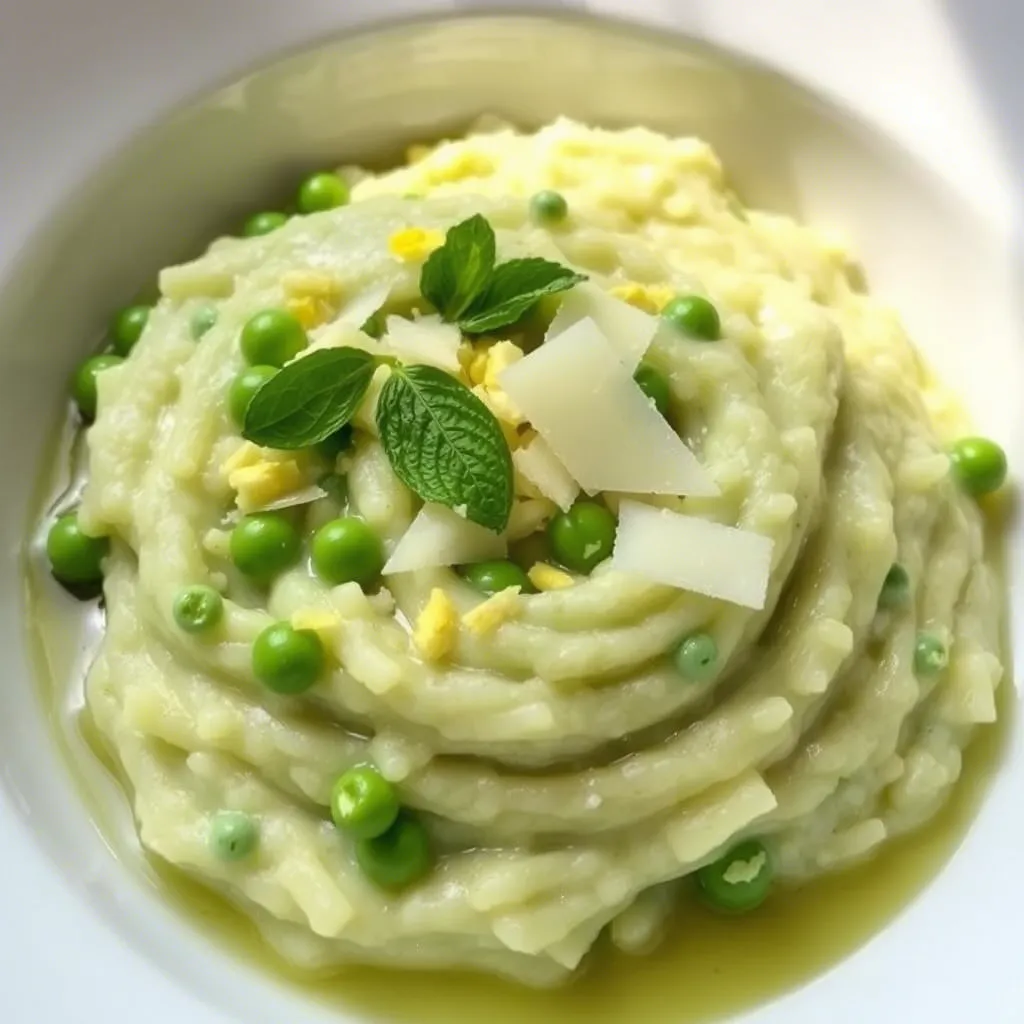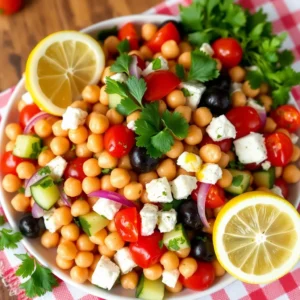Why You’ll Love This Spring Pea Risotto with Lemon and Mint
If you’ve ever stood in your kitchen at 6 PM wondering how on earth to get dinner on the table without spending hours over a hot stove, this Spring Pea Risotto with Lemon and Mint is about to become your new best friend. I know what you’re thinking—risotto? Isn’t that one of those fancy-sounding dishes that takes forever and demands constant stirring like it’s some kind of culinary yoga pose? Well, not exactly.
Let me let you in on a little secret: this version is so much easier than you’d expect, and it still delivers that creamy, dreamy texture we all associate with restaurant-quality risotto. It’s perfect for busy weeknights when you want something comforting but don’t have the time (or energy) to slave over complicated recipes. Plus, with just the right balance of bright lemon zest and fresh mint, this dish feels like a breath of fresh air on your plate—literally and figuratively.
Now, I’ll be honest, there is a bit of stirring involved. But think of it as therapeutic multitasking. While the rice gently absorbs all that delicious broth, you can chop veggies, prep sides, or even sneak in a few sips of wine while no one’s looking. And here’s the kicker: you don’t need any fancy ingredients. Just basic pantry staples, a handful of fresh produce, and a little patience.
This spring risotto is also incredibly forgiving. If you forget to stir once or twice (no judgment here), it won’t punish you like some other finicky dishes I could name. The end result is still going to be rich, flavorful, and utterly satisfying. And if you’ve got picky eaters in the house, trust me—you can sneak those peas in like they’re secret agents on a mission to deliver nutrition without protest.
What really sets this dish apart is its versatility. Got leftover chicken or shrimp? Toss it in! Need to make it vegetarian? No problem. Want to impress guests without breaking a sweat? Yep, that works too. Whether you’re feeding a hungry family or enjoying a quiet dinner for two, this recipe adapts beautifully to whatever life throws your way.
And let’s talk about the clean-up. One pot, folks. That’s it. No need to dirty half the kitchen for one meal. In my book, that’s already a win before the first bite.
So if you’re craving something that feels special but doesn’t demand a culinary degree, give this Spring Pea Risotto with Lemon and Mint a try. Your taste buds—and your schedule—will thank you.
The Story Behind This Spring Pea Risotto with Lemon and Mint
Every recipe has a story, and this one starts with a chilly April afternoon that somehow forgot it was supposed to feel like spring. I was rummaging through the fridge after a long day, trying to figure out what to make for dinner when I stumbled upon a bag of frozen peas and a bunch of fresh mint wilting slightly in the crisper drawer. My daughter wandered in and asked, “Are we having pasta again?”—which felt like a sign from the universe that it was time to shake things up.
I remembered a risotto recipe my grandmother used to make during the warmer months. She always said that food should reflect the season—not just in ingredients, but in spirit. Back then, I was intimidated by risotto. All that stirring! All that waiting! But now, years later and with a few more kitchen adventures under my belt, I realized I could create a version that honored her tradition while fitting into our modern, fast-paced lives.
That night, I combined Arborio rice with homemade vegetable broth, fresh peas, lemon zest, and a handful of mint. I stirred, I tasted, I adjusted. And when I finally plated it up, the look on my daughter’s face was priceless. “This tastes like sunshine,” she said, which made me laugh and tear up a little all at once.
Since then, this Spring Pea Risotto with Lemon and Mint has become a staple in our household. My kids ask for it weekly, and honestly, I don’t mind making it because it brings such joy to our table. It’s one of those dishes that reminds us to slow down, even if just for a moment, and appreciate the simple pleasures of good food and good company.
In fact, I shared this recipe recently with a neighbor who was recovering from surgery. She texted me the next day saying it was the most comforting thing she’d eaten in weeks. That’s the power of food—it nourishes more than just the body; it feeds the soul.
So whether you’re cooking for yourself, your family, or someone who needs a little extra love, this spring risotto is more than just a meal. It’s a reminder that sometimes the simplest combinations can bring the most happiness. And isn’t that what cooking is all about?
Before we move on to the ingredients and step-by-step execution, here’s a link to another quick and satisfying lunch recipe you might enjoy: Easy Crepes Recipe . Perfect for when you want something elegant but easy!
Ingredients
Let’s talk ingredients. This Spring Pea Risotto with Lemon and Mint is built on a foundation of simple, high-quality components that come together to create something truly special. I like to think of risotto as the culinary equivalent of a symphony orchestra—each ingredient plays its part, and when they all work together, magic happens.
The Star Players
Arborio Rice (1 ½ cups): The backbone of any good risotto. Arborio rice has a high starch content, which gives risotto that signature creamy texture without needing heavy cream. It’s like the unsung hero of the dish—quiet but powerful.
Vegetable Broth (4–5 cups): You can absolutely use chicken broth if you’re not keeping it vegetarian, but I prefer vegetable for a lighter, fresher flavor. Make sure it’s warm before adding it to the rice—it helps maintain an even cooking temperature and prevents shocking the grains.
Fresh Peas (1 cup): These little green gems are packed with sweetness and add a pop of color that just screams “spring!” If fresh peas aren’t in season or you’re short on time, frozen peas work beautifully too—just make sure to thaw them first so they don’t cool down your pan.
Lemon (Zest and Juice of 1): Bright, zesty lemon is what lifts this risotto from comforting to refreshing. I always recommend using a microplane to zest your lemon—it captures all those aromatic oils that give the dish its citrusy sparkle.
Fresh Mint (¼ cup, chopped): Mint adds a surprising but delightful freshness that pairs perfectly with peas and lemon. Don’t skip it! If you don’t have mint on hand, fresh parsley or basil can step in, but mint really makes this dish sing.
White Onion (½ medium, finely chopped): A small amount goes a long way here. The onion softens beautifully and provides a gentle savory base without overpowering the other flavors.
Butter (2 tablespoons): For richness and depth. Butter is one of those ingredients that just makes everything taste better. If you want to keep it dairy-free, coconut oil or vegan butter works well.
Parmesan Cheese (½ cup, grated): Parmesan adds a salty, umami kick that ties everything together. If you’re avoiding dairy, nutritional yeast or vegan Parmesan are great alternatives.
Olive Oil (1 tablespoon): Used to sauté the onions and help toast the rice. Choose a good quality extra virgin olive oil for the best flavor.
Salt and Black Pepper (To taste): Seasoning is key! Taste as you go and adjust accordingly.
Execution
Alright, let’s get cooking! This Spring Pea Risotto with Lemon and Mint comes together in about 45 minutes—perfect for a cozy weeknight dinner that still feels special.
Step 1: Prep Your Ingredients (10 Minutes)
Before you start cooking, take a few minutes to chop your onion, zest and juice your lemon, and measure out your broth. Having everything ready will make the process much smoother, especially since risotto requires a bit of attention once you get going.
Pro tip: Warm your broth in a saucepan over low heat while you prep. Adding warm liquid to your rice helps it cook more evenly and absorb flavors better.
Step 2: Sauté the Aromatics (3 Minutes)
Heat the olive oil and 1 tablespoon of butter in a large, heavy-bottomed skillet or Dutch oven over medium heat. Once the butter melts and starts to foam slightly, add the chopped onion. Cook for about 2–3 minutes until softened and translucent—no browning needed here.
Step 3: Toast the Rice (2 Minutes)
Add the Arborio rice to the pan and stir to coat each grain in the buttery goodness. Toast the rice for about 2 minutes until it becomes slightly opaque and smells nutty. This step is important—it primes the rice to soak up all that delicious broth later on.
Step 4: Deglaze with Wine (Optional, 1 Minute)
If you’re using wine, now’s the time to add it! Pour in about ½ cup of dry white wine and stir constantly until most of the liquid evaporates and the alcohol smell dissipates. This adds a subtle complexity that takes your risotto from good to wow .
Step 5: Add Broth Gradually (20–25 Minutes)
Now comes the part where patience pays off. Begin adding your warm broth one ladle at a time, stirring frequently after each addition. Wait until the liquid is almost fully absorbed before adding more. This slow process allows the rice to release its starches gradually, creating that luxurious, creamy texture.
Stirring might feel tedious, but I promise it’s worth it. Think of it as your kitchen therapy session—no need to rush. While the rice cooks, you can set the table, pour yourself a glass of wine, or simply enjoy the lovely aroma filling your home.
After about 20–25 minutes, the rice should be tender but still have a slight bite (al dente). If you run out of broth before the rice is done, no worries—just add warm water.
Step 6: Stir in Peas and Herbs (2 Minutes)
Once the rice is cooked to your liking, stir in the peas and chopped mint. They’ll soften slightly and infuse the risotto with their vibrant flavors.
Step 7: Finish with Butter and Parmesan (2 Minutes)
Remove the pan from the heat and stir in the remaining tablespoon of butter and the grated Parmesan cheese. This is called mantecatura in Italian cooking—it’s what gives risotto that silky, restaurant-quality finish. Stir vigorously until everything is melted and incorporated.
Step 8: Add Lemon Zest and Juice (1 Minute)
Finally, stir in the lemon zest and juice. This is where the dish really comes alive! The acidity brightens everything up and balances the richness of the butter and cheese.
Step 9: Serve and Enjoy (Immediate Gratification!)
Serve immediately while hot and creamy. Garnish with extra mint leaves, a sprinkle of Parmesan, and a few lemon wedges on the side for anyone who wants an extra burst of citrus.
And there you have it—a beautiful, comforting, and surprisingly easy Spring Pea Risotto with Lemon and Mint that tastes like it came straight from a fancy trattoria. But here’s the secret: it was made by you , in your own kitchen, with love and intention.
For another quick and satisfying lunch idea, check out my One-Pan Chicken and Mushroom Alfredo —it’s the ultimate comfort food shortcut!
Want to impress guests? Try pairing this risotto with a crisp white wine like Sauvignon Blanc or a light Pinot Grigio. And if you’re looking for a show-stopping dessert to follow, my Lemon Ricotta Cake with Honey Glaze is the perfect match.
Additional Tips
Now that you’ve mastered the basics of this Spring Pea Risotto with Lemon and Mint , let’s take it a step further. These tips will help you customize, troubleshoot, and elevate your risotto game so every batch feels like a fresh kitchen win.
Storage & Reheating Like a Pro
One of the great things about risotto is how well it stores—yes, even though it’s best served fresh! If you’ve got leftovers (though I won’t blame you if you don’t), store them in an airtight container in the fridge for up to 3 days. When reheating, add a splash of broth or water to loosen the texture—it tends to firm up a bit in the fridge.
Microwave? Sure thing—heat in short bursts, stirring between each to keep it creamy. Stovetop lovers can gently reheat over medium-low heat while stirring constantly. Either way, finish with a touch of butter or Parmesan to bring back that signature silkiness.
Make It Your Own
This recipe is incredibly versatile, so feel free to get creative! Here are some fun variations:
- Add Protein: Stir in shredded cooked chicken, sautéed shrimp, or crispy pancetta for a heartier meal.
- Swap Greens: If mint isn’t your thing, try basil or parsley. For a more earthy flavor, stir in a handful of baby spinach or arugula at the end.
- Go Vegan: Use vegan butter and skip the Parmesan—or substitute with nutritional yeast or vegan cheese for that umami kick.
- Try Different Veggies: Asparagus, zucchini, or roasted carrots all make excellent additions. Just be sure to cook them separately before folding into the finished risotto.
Timing Is Everything
Risotto doesn’t like to wait around—it’s happiest when served immediately. But life happens, right? If you’re cooking for guests or juggling multiple dishes, here’s a pro tip: finish the risotto just shy of al dente, then cover and set aside for 5–10 minutes while you prep other components. The residual heat keeps it moving toward perfection without overcooking.
If you find yourself needing to pause longer than that, keep a small pot of warm broth nearby. Add a few spoonfuls when you resume cooking to bring everything back to that dreamy creaminess.
Troubleshooting Common Issues
Even the most experienced cooks run into hiccups now and then. Here’s how to fix common problems:
- Too Thick? No worries! Simply stir in a bit more warm broth or water until you reach your desired consistency.
- Too Thin? Let it simmer uncovered for a few extra minutes to reduce and thicken naturally.
- Lumpy Sauce? That’s just flavor-packed charm! But if you prefer silky smoothness, give it a quick whisk or gentle stir with a wooden spoon.
- Bland Flavor? A final sprinkle of flaky sea salt, a squeeze of lemon, or an extra grating of Parmesan can work wonders.
Presentation Matters
Let’s face it—food tastes better when it looks beautiful. Serve your Spring Pea Risotto with Lemon and Mint in warm white bowls to really make those vibrant colors pop. Garnish with fresh mint leaves, a light dusting of Parmesan, and maybe even a few edible flowers if you’re feeling fancy.
Pair it with a crisp white wine like Sauvignon Blanc or a refreshing cucumber salad for a full spring experience. And don’t forget the crusty bread on the side—it’s perfect for soaking up any leftover sauce.
FAQs
Q: Can I use frozen peas instead of fresh?
A: Absolutely! Frozen peas are convenient and still deliver great flavor. Just be sure to thaw them first so they don’t cool down your risotto too quickly when added.
Q: Is there a shortcut method for making risotto?
A: While traditional risotto requires gradual stirring and adding broth, you can try the “bake and stir” method: Cook the rice and aromatics on the stovetop, then transfer everything to the oven to finish baking. It cuts down on hands-on time while still achieving that creamy texture.
Q: Can I make this ahead of time?
A: Risotto is best enjoyed fresh, but you can start prepping early by chopping veggies and warming your broth. If you need to pause during cooking, simply cover and let it rest for 10–15 minutes before continuing.
Q: How do I keep my risotto from sticking?
A: Use a wide, heavy-bottomed pan and stir frequently—especially after adding each ladle of broth. This prevents the rice from settling and burning at the bottom.
Q: What can I substitute for Arborio rice?
A: Carnaroli rice is another excellent option with similar starch content. If neither is available, short-grain sushi rice works in a pinch, though the texture may vary slightly.
Q: Can I freeze leftover risotto?
A: Yes, but with a caveat! Freeze individual portions in airtight containers for up to 2 months. When reheating, add extra liquid (broth or water) to restore its creamy texture.
Q: Why does my risotto taste bland?
A: Seasoning is key! Taste as you go and adjust salt, pepper, and Parmesan accordingly. A final squeeze of lemon juice can also brighten everything up.
For more helpful cooking tips and tricks, check out my post on How to Master the Art of Cooking Rice —it’s packed with handy advice!
And if you ever want to dive deeper into Italian cuisine, I highly recommend checking out Serious Eats’ guide to The Science of Risotto . It’s fascinating stuff—and totally worth the read if you’re serious about perfecting your technique.
So there you have it—a complete guide to making this Spring Pea Risotto with Lemon and Mint your own. Whether you’re cooking for one or feeding a crowd, this dish brings warmth, comfort, and a touch of seasonal magic to your table.
Until next time, happy cooking—and remember, sometimes the simplest meals make the biggest impact.



